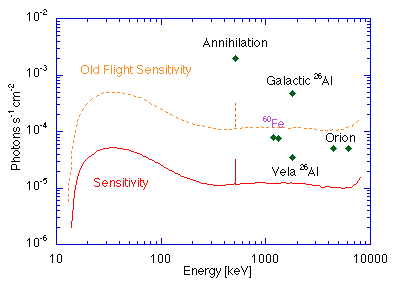The Future: GRIS Long Duration Balloon Flight
The GRIS experiment is arguably one of the most successful gamma-ray balloon programs in history. It produced breakthrough scientific results on many of its 9 flights, contributing significantly to the study of nucleosynthetic 56Co lines from SN1987A, the galactic 511 keV annihilation line, and the galactic 26Al line (1.809 MeV) among other things. GRIS has been a follow-on for earlier successful pioneering programs (Bell/Sandia, Leventhal; LEGS, Teegarden). We are proposing to take the next logical step in this sequence. Namely to move GRIS to the University of Maryland campus and refurbish it for the exciting new Long Duration Balloon (LDB) program. Our intention is to involve undergraduate and graduate students in the program in a major way so as to give the program a strong educational and outreach component and also to reduce its cost. For a very modest amount of money, exciting satellite-quality data is achievable. By configuring GRIS to do wide field-of-view (FOV, 120x70 degrees) studies of diffuse emission, the program will be aimed at science that INTEGRAL cannot effectively address. For such lines, GRIS will achieve a narrow line sensitivity of the order of 10-5 photons cm-2 s-1. This is about a factor of 5 better than the CGRO sensitivity achieved with low resolution instruments. Narrow lines tend to come from diffuse sources, so a Ge spectrometer should have a wide FOV to be most effective. This is the specialty of this new incarnation of GRIS.
Scientific Objectives- The first detection of diffuse nucleosynthetic 60Fe (1.17 and 1.33 MeV) lines each at the 10 sigma level. After 15 years, we now believe that the 26Al radiation is produced by supernovae in the galaxy. According to Stan Woosley (UCSB) and others, about 16% as much 60Fe should be simultaneously produced allowing us to finally establish the origin of this radioactivity.
- The elaboration of the first map of 26Al radiation done with high-energy resolution. The new GRIS results suggest that the line width and shape may vary over the galaxy because of the high speed of the material.
- The first detection of nucleosynthetic edges in the cosmic diffuse background. Clayton (Clemson U.), and recently Zdziarski (Copernicus Astro. Cntr.), have predicted that 56Co produced in extragalactic supernova will generated detectable edges around 847 and 1238 keV attached to redshifted features as we look deeper into the universe. No other current or planned instrument can do this science.
- The study of the diffuse galactic 511 keV line with enough statistics (50 sigma) to allow a study of the lineshape. The work of Ramaty (NASA/GSFC), Leventhal (UMD), and their colleagues indicates that the lineshape should reveal the nature of the stopping medium.
- The study of the Orion low energy cosmic-ray interaction nuclear lines (4.4 and 6.2 MeV) with a high-energy resolution system.
- The detection of gamma-ray bursts (about 10) with a large volume of germanium. This will allow the search for features in much weaker bursts.
- The detection of cosmic-ray interaction lines from the galaxy. Ramaty and his colleagues predict that some number of these lines should be narrow and detectable by GRIS. Target material tied up in dust grains allows the entire grain to recoil from the proton impact and yield narrow 56Fe lines for example.

GRIS LDB three sigma narrow line sensitivity for diffuse sources for a 100-day balloon flight. The points show the predicted and observed line emissions for the different scientific objectives, which are above the sensitivity limits. In the case of the C and O emissions from Orion, the instrument will be sensitive enough for lines not broader than 20 keV.
 Return to GRIS Homepage
Return to GRIS Homepage
|
